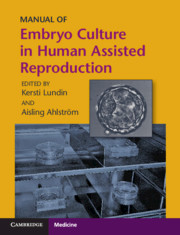Book contents
- Manual of Embryo Culture in Human Assisted Reproduction
- Cambridge Laboratory Manuals in Assisted Reproductive Technology
- Manual of Embryo Culture in Human Assisted Reproduction
- Copyright page
- Contents
- Contributors
- Preface
- Chapter 1 Facilities for Embryo Culture
- Chapter 2 Incubators for Embryo Culture
- Chapter 3 Consumables for the IVF Laboratory
- Chapter 4 Embryo Metabolism and What Does the Embryo Need?
- Chapter 5 Culture Media and Embryo Culture
- Chapter 6 Optimal Handling Techniques for Culture of Human Embryos
- Chapter 7 From Identification to Witnessing
- Chapter 8 Timing of Embryo Culture
- Chapter 9 Time-Lapse Technology
- Chapter 10 Laboratory Monitoring for Embryo Culture
- Chapter 11 Embryo Culture and IVF Offspring Outcome
- Chapter 12 The Changing Culture of Embryo Culture
- Index
- Plate Section (PDF Only)
- References
Chapter 5 - Culture Media and Embryo Culture
Published online by Cambridge University Press: 15 April 2021
- Manual of Embryo Culture in Human Assisted Reproduction
- Cambridge Laboratory Manuals in Assisted Reproductive Technology
- Manual of Embryo Culture in Human Assisted Reproduction
- Copyright page
- Contents
- Contributors
- Preface
- Chapter 1 Facilities for Embryo Culture
- Chapter 2 Incubators for Embryo Culture
- Chapter 3 Consumables for the IVF Laboratory
- Chapter 4 Embryo Metabolism and What Does the Embryo Need?
- Chapter 5 Culture Media and Embryo Culture
- Chapter 6 Optimal Handling Techniques for Culture of Human Embryos
- Chapter 7 From Identification to Witnessing
- Chapter 8 Timing of Embryo Culture
- Chapter 9 Time-Lapse Technology
- Chapter 10 Laboratory Monitoring for Embryo Culture
- Chapter 11 Embryo Culture and IVF Offspring Outcome
- Chapter 12 The Changing Culture of Embryo Culture
- Index
- Plate Section (PDF Only)
- References
Summary
Before considering the basis of embryo culture medium, it is worthwhile reflecting on its function. A detailed overview of embryo metabolism is given in Chapter 4; however, in brief, the embryo must satisfy changing demands for energy by consumption of nutrients from the external milieu (Lewis & Sturmey, 2015). In an in vivo setting, these needs are catered for in a dynamic manner by the secretions of the oviduct; in an in vitro situation, these requirements must be satisfied by the embryo culture medium. In addition to the provision of energy substrates, the medium must also satisfy basic physicochemical requirements. Primarily, the medium must facilitate buffering of pH in response both to changing environments to which the embryo is exposed and to excretion of metabolic waste products, notably lactic acid, which is released by cells with accompanying protons, causing pH to fall. Moreover, the culture medium must avoid inducing osmotic stress. One of the major consumers of cellular energy is the maintenance of intracellular ion composition, maintained through the action of ion pumps. Providing suitable osmolarity and pH are among the most basic requirements of any embryo culture medium.
- Type
- Chapter
- Information
- Manual of Embryo Culture in Human Assisted Reproduction , pp. 42 - 52Publisher: Cambridge University PressPrint publication year: 2021



